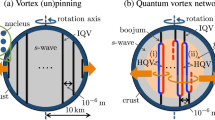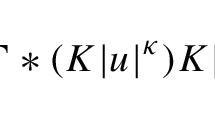Abstract
A rotating star may be modeled as a continuous system of particles attracted to each other by gravity and with a given total mass and prescribed angular velocity. Mathematically this leads to the Euler–Poisson system. We prove an existence theorem for such stars that are rapidly rotating, depending continuously on the speed of rotation. This solves a problem that has been open since Lichtenstein’s work (Math Z 36(1):481–562, 1933). The key tool is global continuation theory, combined with a delicate limiting process. The solutions form a connected set \({\mathcal{K}}\) in an appropriate function space. As the speed of rotation increases, we prove that the supports of the stars in \({\mathcal{K}}\) become unbounded if we assume for instance an equation of state of the form \({p=\rho^\gamma,\ 4/3 < \gamma < 2}\). On the other hand, if \({6/5 < \gamma < 4/3}\), we prove that either the supports of the stars in \({\mathcal{K}}\) become unbounded or the density somewhere within the stars becomes unbounded. We consider two formulations, one where the angular velocity is prescribed and the other where the angular momentum per unit mass is prescribed.
Similar content being viewed by others
References
Alexander J., Yorke J.A.: The implicit function theorem and the global methods of cohomology. J. Funct. Anal. 21(3), 330–339 (1976)
Auchmuty G.: The global branching of rotating stars. Arch. Ration. Mech. Anal. 114(2), 179–193 (1991)
Auchmuty J., Beals R.: Variational solutions of some nonlinear free boundary problems. Arch. Ration. Mech. Anal. 43(4), 255–271 (1971)
Caffarelli L.A., Friedman A.: The shape of axisymmetric rotating fluid. J. Funct. Anal. 35(1), 109–142 (1980)
Chanillo S., Li Y.Y.: On diameters of uniformly rotating stars. Commun. Math. Phys. 166(2), 417–430 (1994)
Friedman A., Turkington B.: Existence and dimensions of a rotating white dwarf. J. Differ. Equ. 42(3), 414–437 (1981)
Gidas B., Ni W.-M., Nirenberg L.: Symmetry and related properties via the maximum principle. Commun. Math. Phys. 68(3), 209–243 (1979)
Heilig, U.: On Lichtenstein’s analysis of rotating Newtonian stars. In: Annales de l’IHP Physique Théorique, vol. 60, pp. 457–487 (1994)
Jang J., Makino T.: On slowly rotating axisymmetric solutions of the Euler–Poisson equations. Arch. Ration. Mech. Anal. 225(2), 873–900 (2017)
Jardetzky W.S.: Theories of Figures of Celestial Bodies. Courier Corporation, North Chelmsford (2013)
Kielhöfer H.: Bifurcation Theory: An Introduction with Applications to PDEs, vol. 156. Springer, Berlin (2006)
Li Y.: On uniformly rotating stars. Arch. Ration. Mech. Anal. 115(4), 367–393 (1991)
Lichtenstein L.: Untersuchungen über die Gleichgewichtsfiguren rotierender Flüssigkeiten, deren Teilchen einander nach dem Newtonschen Gesetze anziehen. Mathe. Z. 36(1), 481–562 (1933)
Luo T., Smoller J.: Existence and non-linear stability of rotating star solutions of the compressible Euler–Poisson equations. Arch. Ration. Mech. Anal. 191(3), 447–496 (2009)
Makino T.: On the existence of positive solutions at infinity for ordinary differential equations of emden type. Funkc. Ekvacioj 27(3), 319–329 (1984)
McCann R.J.: Stable rotating binary stars and fluid in a tube. Houst. J. Math. 32(2), 603–631 (2006)
Nirenberg L.: Topics in Nonlinear Functional Analysis, vol. 6. American Mathematical Soc., Providence (1974)
Rabinowitz P.H.: Some global results for nonlinear eigenvalue problems. J. Funct. Anal. 7(3), 487–513 (1971)
Strauss W.A., Wu Y.: Steady states of rotating stars and galaxies. SIAM J. Math. Anal. 49(6), 4865–4914 (2017)
Wu Y.: On rotating star solutions to the non-isentropic Euler–Poisson equations. J. Differ. Equ. 259(12), 7161–7198 (2015)
Wu Y.: Existence of rotating planet solutions to the Euler–Poisson equations with an inner hard core. Arch. Ration. Mech. Anal. 219(1), 1–26 (2016)
Acknowledgements
YW is supported by NSF Grant DMS-1714343. WS and YW also acknowledge the support of the spring 2017 semester program at ICERM (Brown U.), where much of this work was done.
Author information
Authors and Affiliations
Corresponding author
Additional information
Communicated by C. De Lellis
Publisher’s Note
Springer Nature remains neutral with regard to jurisdictional claims in published maps and institutional affiliations.
Rights and permissions
About this article
Cite this article
Strauss, W.A., Wu, Y. Rapidly Rotating Stars. Commun. Math. Phys. 368, 701–721 (2019). https://doi.org/10.1007/s00220-019-03414-7
Received:
Accepted:
Published:
Issue Date:
DOI: https://doi.org/10.1007/s00220-019-03414-7




